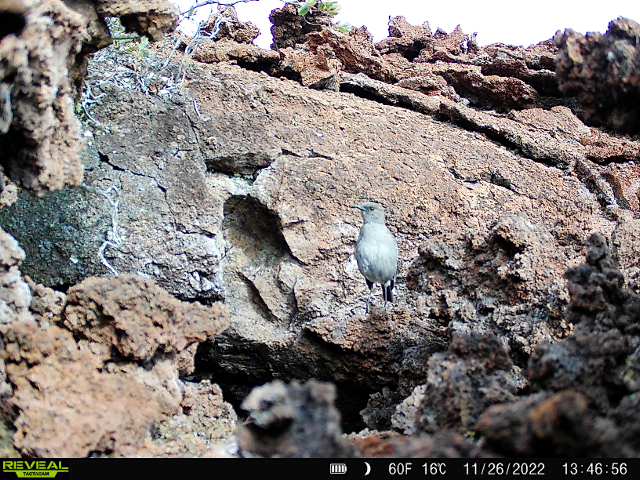Less than 24-hours after the current eruption of Mauna Loa began, Steve Bergfeld, the Hawai‘i Island Branch Chief with the DLNR Division of Forestry and Wildlife (DOFAW) worried most about the Pu‘u Maka‘ala Natural Area Reserve (NAR) on the southeast side of the mountain. At that time lava flows were headed into the northeast rift zone of Mauna Loa.
“Obviously the biggest concern we have is public resources and people’s property being impacted. One of the areas we were most concerned about is the NAR. There’s a lot of endangered species and really good forest habitat in Pu‘u Maka‘ala that we’d hate to see lost,” Bergfeld said.
His concern is valid, as previous eruptions in 1942 and 1984 surrounded Pu‘u Maka‘ala with vast expanses of hardened lava right outside ungulate fencing surrounding the NAR.
Shortly after the eruption began Nick Agorastos, the Natural Area Reserve Program Manager for Hawai‘i Island said he was concerned right away. “I started making calls to find out where the lava was headed. We’ve made tremendous investments into the watershed and ecosystems of Pu‘u Maka‘ala. We have a lot of resources that if push came to shove, we could pull them if they were in jeopardy.”
Agorastos says he started thinking through various scenarios and obviously he did not want to put people in danger, “but some of the resources in the NAR are irreplaceable.”
From clearings in Pu‘u Maka‘ala, the cloud of volcanic gasses from the Fissure 3 fountain on Mauna Loa is visible as it extends high into the sky. For now, everyone is breathing a sigh of relief that one of the most valuable, intact native forests in the state has not been impacted.
Earlier this week, a DOFAW field team was at Pu‘u Maka‘ala running mist net lines to capture native forest birds, like the ‘Ōma’o. They’re found both in the Mauna Loa Forest Reserve and the adjoining Pu‘u Maka‘ala NAR.
Bret Nainoa Mossman, Avian Ecologist for the Hawai‘i Island NAR Program said ‘Ōma’o are exciting birds because they’re one of the few remaining native species that primarily eat fruit. “So they’re really important for spreading native plant seeds around the forest,” he explained. That becomes doubly important as they spread seeds across lava fields.
“Another cool thing about them is that the population up on Mauna Loa is still hopping around the lava right near the active fissure. They’re just living their best life up in that high-elevation zone.”
While, Mossman says subalpine ‘Ōma’o are likely moving away from active lava flows, the VOG is certainly having some effect. “It’s interesting, as we’ve been catching them on field cameras near U‘au burrows, so I’m wondering if they may be going in burrows to shelter from the worst of the VOG.”
The lava bullet has been dodged at Pu‘u Maka‘ala…for now and at least this time. “We’ve spent a lot of years working with Three Mountain Alliance and its watershed-protection predecessor fencing and removing ungulates from the area. It’s been free of ungulates for many years and the forest is recovering well. We’ve done a great deal of plant and endangered species restoration work and monitoring in the NAR,” Bergfeld added.
“After all this work we didn’t want to start over. Forests take many decades to mature, so any loss of critical watershed forest like Pu‘u Maka‘ala is basically permanent…it may never get back to the same point. It’s going to be a novel forest and it will look quite different,” Agorastos explained.
As for impacts in the Mauna Loa Forest Reserve, surveys will have to wait until the eruption is over. Fortunately, it appears that most of the impacted land was former lava flows.
Game Management Unit Reopens
DOFAW is also announcing the re-opening of the Kapāpala Cooperative Game Management Area, Unit J for game bird hunting on Saturday Dec. 10 and through the 2022-2023 game bird season, pending no further volcanic hazards. Kapāpala Forest Reserve and the ʻĀinapō Trail remain closed.

